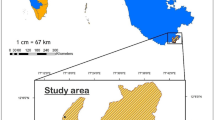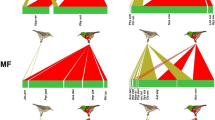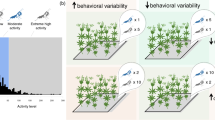Abstract
Predator–prey interactions strongly affect ecological dynamics. Consistent inter-individual differences in behaviour (individual behavioural types, BTs) of predator and prey (or both) may fundamentally shape their mutual interactions. Several recent studies have shown that it is important to consider the interaction of BTs on both sides of predator–prey interactions. Otherwise, there is a high risk of erroneous inference about the outcome of predation. Until now, however, no study has investigated how BT vs BT interaction affects the predation of mesopredators by top predators, especially when the mesopredator is a low-ranked prey for the top predator. Such knowledge is extremely important if we want to predict the effect of individual BTs on food web dynamics. We have investigated in our laboratory experiments how foraging aggressiveness of the top predator (spider, Philodromus cespitum, Philodromidae) and risk-aversion as a form of shyness of the mesopredator (spider, Philodromus albidus, Philodromidae) determine the probability of predation. The highest explanatory power had the model with additive effects of mesopredator’s risk-aversion and top predator’s foraging aggressiveness. Other models, including those with BT vs BT interaction, had poor explanatory power. It was probably due to the fact that timid top predators are often choosy and do not catch low-ranked prey, while aggressive top predators are opportunists. The risk-averse mesopredators are also more cautious than risk-prone mesopredators regarding their surroundings and can defend themselves faster. Our results therefore fit with the classical hypothesis about trade-off between foraging and safety.
Significance statement
Behavioural types of predator and prey jointly determine the mortality of prey. In our laboratory experiments, we investigated how foraging aggressiveness of a top predator spider and the risk-aversion of a mesopredator spider (potential prey) determine the probability of predation. We demonstrated that top predator’s foraging aggressiveness and mesopredator’s risk-aversion determine the probability of mesopredator’s mortality only additively. The mesopredator’s probability of being killed decreased with its risk-aversion and increased with top predator’s foraging aggressiveness. The effect was additive instead of interactive because the mesopredator represents a dangerous prey for the top predator. The timid top predators are also choosy and do not attack dangerous prey, while the aggressive/non-choosy top predators are opportunistic. Further, the risk-averse mesopredators are more cautious regarding their surroundings and can react faster to the presence of a top predator, compared to risk-prone and slowly reacting mesopredators.



Similar content being viewed by others
References
Bell RD, Rypstra AL, Persons MH (2006) The effect of predator hunger on chemically mediated antipredator responses and survival in the wolf spider Pardosa milvina (Araneae: Lycosidae). Ethology 112:903–910
Bell AM, Hankison SJ, Laskowski KL (2009) The repeatability of behaviour: a meta-analysis. Anim Behav 77:771–783
Buchar J, Růžička V (2002) Catalogue of spiders of the Czech Republic. Peres publishers, Praha
Carere C, Maestripieri D (2013) Animal personalities. Behavior, physiology, and evolution. The University of Chicago Press, Chicago
Chang C, Teo HY, Norma-Rashid Y, Li D (2017) Predator personality and prey behavioural predictability jointly determine foraging performance. Sci Rep 7:40734
DiRienzo N, Pruitt JN, Hedrick AV (2013) The combined behavioural tendencies of predator and prey mediate the outcome of their interaction. Anim Behav 86:317–322
Foelix RF (2011) Biology of spiders. Oxford University Press, Oxford
Gosling SD (2001) From mice to men: what can we learn about personality from animal research? Psychol Bull 127:45–86
Haynes DL, Sisojević P (1966) Predatory behavior of Philodromus rufus Walckenaer (Araneae: Thomisidae). Can Entomol 98:113–133
Huey RB, Pianka ER (1981) Ecological consequences of foraging mode. Ecology 62:991–999
Ingram T, Svanbäck R, Kraft NJ, Kratina P, Southcott L, Schluter D (2012) Intraguild predation drives evolutionary niche shift in threespine stickleback. Evolution 66:1819–1832
Jones KA, Godin JGJ (2010) Are fast explorers slow reactors? Linking personality type and anti-predator behaviour. Proc R Soc Lond 277:625–632
Lichtenstein JL, Wright CM, McEwen B, Pinter-Wollman N, Pruitt JN (2017) The multidimensional behavioural hypervolumes of two interacting species predict their space use and survival. Anim Behav 132:129–136
Maupin JL, Riechert SE (2001) Superfluous killing in spiders: a consequence of adaptation to food-limited environments? Behav Ecol 12:569–576
McGhee KE, Pintor LM, Bell AM (2013) Reciprocal behavioral plasticity and behavioral types during predator-prey interactions. Am Nat 182:704–717
Michalko R, Košulič O (2016) Temperature-dependent effect of two neurotoxic insecticides on predatory potential of Philodromus spiders. J Pest Sci 89:517–527
Michalko R, Pekár S (2014) Is different degree of individual specialisation in three closely related spider species caused by different selection pressures? Basic Appl Ecol 15:496–506
Michalko R, Pekár S (2015a) The biocontrol potential of Philodromus (Araneae, Philodromidae) spiders for the suppression of pome fruit orchard pests. Biol Control 82:13–20
Michalko R, Pekár S (2015b) Niche partitioning and niche filtering jointly mediate coexistence among three closely related spider species (Araneae, Philodromidae). Ecol Entomol 40:22–33
Michalko R, Pekár S (2016) Different hunting strategies of generalist predators result in functional differences. Oecologia 181:1187–1197
Michalko R, Pekár S (2017) Behavioral type of a top predator drives the short-term dynamics of intraguild predation. Am Nat 189:242–253
Michalko R, Košulič O, Řežucha R (2017) Link between aggressiveness and shyness in the spider Philodromus albidus (Araneae, Philodromidae): state dependency over stability. J Insect Behav 30:48–59
Moya-Laraño J, Verdeny-Vilalta O, Rowntree J, Melguizo-Ruiz N, Montserrat M, Laiolo P (2012) Climate change and eco-evolutionary dynamics in food webs. Adv Ecol Res 47:1–80
Mukherjee S, Heithaus MR (2013) Dangerous prey and daring predators: a review. Biol Rev 88:550–563
Pekár S, Brabec M (2012) Modern analysis of biological data. 2. Linear models with correlation in R. Muni Press, Brno
Pekár S, Brabec M (2016) Modern analysis of biological data. 1. Generalised linear models in R. Scientia, Prag
Pekár S, Toft S (2015) Trophic specialisation in a predatory group: the case of prey-specialised spiders (Araneae). Biol Rev 90:744–761
Petráková L, Michalko R, Loverre P, Sentenská L, Korenko S, Pekár S (2016) Intraguild predation among spiders and their effect on the pear psylla during winter. Agric Ecosyst Environ 233:67–74
Pruitt JN, Stachowicz JJ, Sih A (2012) Behavioral types of predator and prey jointly determine prey survival: potential implications for the maintenance of within-species behavioral variation. Am Nat 179:217–227
Polis GA, Myers CA, Holt RD (1989) The ecology and evolution of intraguild predation: potential competitors that eat each other. Annu Rev Ecol Evol Syst 20:297–330
R Core Team (2016) A language and environment for statistical computing. R Foundation for Statistical Computing, Vienna http://www.R-project.org
Réale D, Reader SM, Sol D, McDougall PT, Dingemanse NJ (2007) Integrating animal temperament within ecology and evolution. Biol Rev 82:291–318
Royauté R, Pruitt JN (2015) Varying predator personalities generates contrasting prey communities in an agroecosystem. Ecology 96:2902–2911
Sih A, Cote J, Evans M, Fogarty S, Pruitt J (2012) Ecological implications of behavioural syndromes. Ecol Lett 15:278–289
Smith BR, Blumstein DT (2008) Fitness consequences of personality: a meta-analysis. Behav Ecol 19:448–455
Stephens DW, Brown JS, Ydenberg RC (2007) Foraging. Behavior and ecology. The University of Chicago Press, Chicago
Stoffel MA, Nakagawa S, Schielzeth H (2017) rptR: repeatability estimation and variance decomposition by generalized linear mixed-effects models. Methods Ecol Evol 8:1639–1644
Sweeney K, Cusack B, Armagost F, O’Brien T, Keiser CN, Pruitt JN (2013) Predator and prey activity levels jointly influence the outcome of long-term foraging bouts. Behav Ecol 24:1205–1210
Toft S (2013) Nutritional aspects of spider feeding. In: Nentwig W (ed) Spider Ecophysiology. Springer-Verlag, Berlin
Wallach AD, Dekker AH, Lurgi M, Montoya JM, Fordham DA, Ritchie EG (2017) Trophic cascades in 3D: network analysis reveals how apex predators structure ecosystems. Methods Ecol Evol 8:135–142
Webster MM, Ward AJW, Hart PJB (2009) Individual boldness affects interspecific interactions in sticklebacks. Behav Ecol Sociobiol 63:511–520
Wise DH (2006) Cannibalism, food limitation, intraspecific competition, and the regulation of spider populations. Annu Rev Entomol 51:441–465
Wolf M, Van Doorn GS, Leimar O, Weissing FJ (2007) Life-history trade-offs favour the evolution of animal personalities. Nature 447:581–584
Wolf M, Weissing FJ (2010) An explanatory framework for adaptive personality differences. Proc R Soc Lond 365:3959–3968
Zuur AF, Hilbe JM, Ieno EN (2015) A beginner’s guide to GLM and GLMM with R. A frequentist and Bayesian perspective for ecologists. Highland Statistics Ltd, Newburgh
Acknowledgements
We would like to thank the anonymous reviewers for their comments that greatly improved the manuscript. We are grateful to Nicole H Cernohorsky for English editing.
Funding
The study was supported by the Specific University Research Fund of the FFWT Mendel University in Brno (reg. no. LDF_PSV_2017004/2017).
Author information
Authors and Affiliations
Corresponding author
Ethics declarations
Conflict of interest
The authors declare that they have no conflict of interest.
Ethical approval
All applicable international, national, and/or institutional guidelines for the care and use of animals were followed.
Additional information
Communicated by J. Pruitt
Rights and permissions
About this article
Cite this article
Michalko, R., Řežucha, R. Top predator’s aggressiveness and mesopredator’s risk-aversion additively determine probability of predation. Behav Ecol Sociobiol 72, 105 (2018). https://doi.org/10.1007/s00265-018-2520-8
Received:
Revised:
Accepted:
Published:
DOI: https://doi.org/10.1007/s00265-018-2520-8




